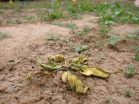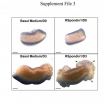Root bacteria are known to form symbiotic relationships with plants by improving the plants' supply of nutrients. Yet as scientists at the Max Planck Institute for Chemical Ecology in Jena, Germany, found recently, the bacteria actually play a much more profound role. During field experiments in Utah, in the western USA, researchers discovered that the right mixture of soil microbiota directly influences the survival of Nicotiana attenuata, a species of wild tobacco. Plants that had been unable to establish a protective alliance with the vitally important soil bacteria were susceptible to an infectious wilt disease that could kill them overnight. The pathogens that caused the disease had built up and spread because the researchers had been continuously growing this native plant in the same field. Moreover, a sterile medium had been used for germination before the plants had been planted out on the field, a procedure which prevented the plants from recruiting symbiotic bacteria early on, as they normally would do when germinating in nature. The results of the study emphasize the importance of crop rotation to prevent the buildup of soil borne diseases and reveal the complex ecology of plants, especially with respect to the multitude of beneficial and harmful microorganisms that interact with them. (Proceedings of the National Academy of Sciences of the United States of America, August 2015).
Ian Baldwin is the head of the Department of Molecular Ecology at the Max Planck Institute for Chemical Ecology. For almost 20 years, he and his team have been studying the sophisticated defense strategies deployed by the coyote tobacco Nicotiana attenuata against its enemies in the plants' native habitat. At the Lytle Preserve in Utah, USA, his team had used the same field plot for experiments over the last 15 years. Eight years ago, they noticed the first sporadic cases of a plant disease that caused elongated tobacco plants to wilt suddenly. As the number of such cases increased over the years, more and more plants at earlier developmental stages contracted the infection.
In 2012, at the end of the field season, more than half of the test plants had died of sudden wilt disease. Interestingly, other native plants in the field showed no symptoms; the disease seemed only to affect tobacco plants. The scientists appeared to have inadvertently produced a typical agricultural dilemma by planting the same wild plant species in the same field over the years: the plant pathogens built up and spread as a result of continuous monoculture cropping.
Because the researchers only use tobacco plants for their field trials, crop rotation was not an option. Therefore they developed different approaches to fight the plant pathogens and tested the effectiveness of these approaches under controlled conditions. First, they isolated bacteria and fungi from the roots of diseased Nicotiana attenuata plants, and identified 70 different bacterial and 36 fungal species, including several plant pathogenic Fusarium and Alternaria species. Next, the scientists retrieved bacterial isolates from the roots of healthy tobacco plants and selected those species that researchers had identified as promoting plant growth and health in previous studies.
Finally, the Max Planck researchers applied conventional chemical fungicides and tried to improve the quality of the soil by adding charcoal; in the wild, young tobacco plants germinate only after wild fires which are commonly started by lightning strikes. In addition to beneficial bacteria, fungi were also selected for biocontrol applications. Neither the treatment with fungicides nor the charcoal turned out to be successful treatment options, and the combination of fungicides and charcoal, as well as a fungal biocontrol treatment, even increased the mortality of the test plants. Mortality was reduced only in plants that had been treated with a mixture of beneficial soil bacteria. The scientists then scrutinized the effect of the bacterial community and compared plants that had been treated with two, three or five different bacterial strains. Although the treatment with just two bacterial strains had virtually no effect, significantly fewer plants died after a treatment with a mix of three or five bacterial strains. Overall, both in vitro and field experiments revealed that individual bacterial strains could realize their full protective potential only when they had the chance to cooperate with other bacterial strains; these synergistic effects contributed to improved plant health and reduced mortality.
"Saying that plants need "healthy soil" has a deeper meaning than we had been aware of until now. It simply means that a balanced microbial soil community is vital for plants to grow and remain healthy. So far, only individual bacterial strains had been applied in agriculture. However, bacteria do not live alone, they form communities which complement each other. Only when they interact with each other they can exert their positive effects on plant health," says Arne Weinhold, who heads the project group "Microbial interactions with Nicotiana attenuata."
"Our results show once again that we can learn a lot when we look very carefully at how nature itself solves such problems. The wilt disease only occurred because we violated the natural behavior of the plants by practicing agricultural methods," Ian Baldwin, who has been studying Nicotiana attenuata for decades, explains. Wild tobacco needs certain conditions to germinate from seed banks in the desert: mostly they depend on soil that has been burned by fires started by lightning strikes. For this reason, wild tobacco populations grow in different areas every year. Previous studies showed that even the very young tobacco seedlings use their endogenous ethylene signaling to recruit certain soil bacteria; in other words, they are actively shaping their root-associated microbiome.
Further investigation is now required to find out how the protective mechanism mediated by the bacterial communities functions, whether individual bacterial species complement each other and how they provide their synergistic effects. "Monocultures in agriculture can eventually lead to increasing crop failure. We must learn to understand how interactions between plants and the incredibly diverse microbial soil community function in order to find out how the equilibrium of this complex ecosystem is upset," says Rakesh Santhanam, a PhD student from India in the International Max Planck Research School and one of the three first authors of the study. Like his co-author Van Thi Luu from Vietnam, he is working on a project supervised by Ian Baldwin. Van Thi Luu, who is a fellow of the International Leibniz Research School for Microbial and Biomolecular Interactions, adds: "Native plants are able to recruit their soil microbial community in order to help them solve context-dependent problems. If we succeed in identifying the plants' microbial community, we can enrich the beneficial microbes so that the plants will have the chance to recruit them for their microbiome at an early developmental stage. This could be an enormous contribution to plant protection." [AO]
INFORMATION:
Original Publication:
Santhanam, R., Luu, V. T., Weinhold, A., Goldberg, J., Oh, Y, Baldwin, I. T. (2015). Native root-associated bacteria rescue a plant from a sudden-wilt disease that emerged during continuous cropping. Proceedings of the National Academy of Sciences of the United States of America. Doi 10.1073/pnas.1505765112
http://dx.doi.org/10.1073/pnas.1505765112
Further Information:
Ian T. Baldwin, Max Planck Institute for Chemical Ecology, Hans-Knöll-Str. 8, 07743 Jena, +49 3641 57-1101, E-Mail baldwin@ice.mpg.de
Arne Weinhold, Max Planck Institute for Chemical Ecology, Hans-Knöll-Str. 8, 07743 Jena, +49 3641 57-1115, E-Mail arweinhold@ice.mpg.de
Rakesh Santhanam, Max Planck Institute for Chemical Ecology, Hans-Knöll-Str. 8, 07743 Jena, +49 3641 57-1115, E-Mail rsanthanam@ice.mpg.de
Van Thi Luu, Max Planck Institute for Chemical Ecology, Hans-Knöll-Str. 8, 07743 Jena, +49 3641 57-1140, E-Mail tluu@ice.mpg.de
Contact and Media Requests:
Angela Overmeyer M.A., Max Planck Institute for Chemical Ecology, Hans-Knöll-Str. 8, 07743 Jena, +49 3641 57-2110, E-Mail overmeyer@ice.mpg.de
Download high-resolution images via http://www.ice.mpg.de/ext/downloads2015.html




